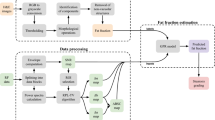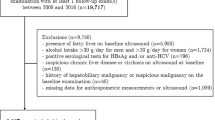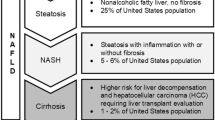Abstract
Background/Objectives:
Obesity is reaching epidemic proportions and is associated with increased risk factors for cardiovascular disease. Leptin-deficient mice (ob/ob) are widely employed to investigate obesity. Aim of this study was to provide a micro-ultrasound (μUS) longitudinal evaluation of the ob/ob mouse model in terms of cardiovascular effects, consequences for renal microcirculation and liver fat accumulation.
Subjects/Methods:
Sixteen wild-type (wt) and eleven ob/ob male mice were studied at 8 (T0) and 25 (T1) weeks of age with a μUS system (Vevo2100) and B-mode and Doppler images were acquired. Cardiac output (CO), ejection fraction (EF), stroke volume (SV), fractional shortening (FS) and E/A ratio were measured from cardiac images. Mean diameter (Dmabd, Dmcar), relative distension (relDabd and relDcar) and pulse wave velocity (PWVabd and PWVcar) were obtained for both abdominal aorta and common carotid. As regards renal microcirculation, renal resistivity and pulsatility index (RI and PI) were assessed. The ratio between grey levels related to liver and kidney (Steato-Score) was used as index of hepatic steatosis.
Results:
At T0, ob/ob mice showed reduced SV, EF, CO and relDabd values and increased LVmass, PWVabd, RI, PI and Steato-score measurements. The same comparison repeated at T1 highlighted similar results for SV, EF, CO, RI, PI and Steato-Score; furthermore, obese mice showed reduced Dmabd and Dmcar measurements in comparison with lean controls. The longitudinal analysis showed an increase in LVmass and Dmabd and a reduction of FS, EF, CO, relDabd and relDcar for wt animals, while no differences were found for the ob/ob group.
Conclusions:
ob/ob mice presented a premature cardiac dysfunction without a further age-related deterioration and a reduction in the abdominal aorta and carotid artery mean diameter in adult age. The proposed analysis can represent a valid approach for longitudinal studies aimed at testing new therapeutic strategies or for characterizing other mouse models.
This is a preview of subscription content, access via your institution
Access options
Subscribe to this journal
Receive 12 print issues and online access
$259.00 per year
only $21.58 per issue
Buy this article
- Purchase on Springer Link
- Instant access to full article PDF
Prices may be subject to local taxes which are calculated during checkout



Similar content being viewed by others
References
Global Health Observatory (GHO) data. http://www.who.int/gho/ncd/risk_factors/obesity_text/en/.
Bastien M, Poirier P, Lemieux I, Després JP . Overview of epidemiology and contribution of obesity to cardiovascular disease. Prog Cardiovasc Dis 2014; 56: 369–381.
Ng M, Fleming T, Robinson M, Thomson B, Graetz N, Margono C et al. Global, regional, and national prevalence of overweight and obesity in children and adults during 1980-2013: a systematic analysis for the Global Burden of Disease Study 2013. Lancet 2014; 384: 766–781.
Hruby A, Hu FB . The epidemiology of obesity: a big picture. Pharmacoeconomics 2015; 33: 673–689.
Masters RK, Reither EN, Powers DA, Yang YC, Burger AE, Link BG . The impact of obesity on US mortality levels: the importance of age and cohort factors in population estimates. Am J Public Health 2013; 103: 1895–1901.
Hurt RT, Kulisek C, Buchanan LA, McClave SA . The obesity epidemic: challenges, health initiatives, and implications for gastroenterologists. Gastroenterol Hepatol 2010; 6: 780–792.
Clarke B, Swinburn B, Sacks G . The application of theories of the policy process to obesity prevention: a systematic review and meta-synthesis. BMC Public Health 2016; 16: 1084.
Hall JE, do Carmo JM, da Silva AA, Wang Z, Hall ME . Obesity-induced hypertension: interaction of neurohumoral and renal mechanisms. Circ Res 2015; 116: 991–1006.
Esser N, Legrand-Poels S, Piette J, Scheen AJ, Paquot N . Inflammation as a link between obesity, metabolic syndrome and type 2 diabetes. Diabetes Res Clin Pract 2014; 105: 141–150.
Ginsberg HN, MacCallum PR . The obesity, metabolic syndrome, and type 2 diabetes mellitus pandemic: Part I. Increased cardiovascular disease risk and the importance of atherogenic dyslipidemia in persons with the metabolic syndrome and type 2 diabetes mellitus. J Cardiometab Syndrome 2009; 4: 113–119.
Abel ED, Litwin SE, Sweeney G . Cardiac remodeling in obesity. Physiol Rev 2008; 88: 389–419.
Wong CY, O'Moore-Sullivan T, Leano R, Byrne N, Beller E, Marwick TH . Alterations of left ventricular myocardial characteristics associated with obesity. Circulation 2004; 110: 3081–3087.
Karelis AD, Rabasa-Lhoret R . Obesity: can inflammatory status define metabolic health? Nat Rev Endocrinol 2013; 9: 694–695.
Klop B, Elte JW, Cabezas MC . Dyslipidemia in obesity: mechanisms and potential targets. Nutrients 2013; 5: 1218–1240.
Stapleton PA, James ME, Goodwill AG, Frisbee JC . Obesity and vascular dysfunction. Pathophysiology 2008; 15: 79–89.
Schinzari F, Tesauro M, Cardillo C . Endothelial and perivascular adipose tissue abnormalities in obesity-related vascular dysfunction: novel targets for treatment. J Cardiovasc Pharmacol 2017. e-pub ahed of print 201769: 360–368.
King RJ, Ajjan RA . Vascular risk in obesity: facts, misconceptions and the unknown. Diab Vasc Dis Res 2017; 14: 2–13.
Chade AR, Hall JE . Role of the renal microcirculation in progression of chronic kidney injury in obesity. Am J Nephrol 2016; 44: 354–367.
Gabbay E, Slotki I, Shavit L . Weighing the evidence: obesity, metabolic syndrome, and the risk of chronic kidney disease. BMC Nephrol 2015; 16: 133.
Fabbrini E, Sullivan S, Klein S . Obesity and nonalcoholic fatty liver disease: biochemical, metabolic, and clinical implications. Hepatology 2010; 51: 679–689.
Lutz TA, Woods SC . Overview of animal models of obesity. Curr Protoc Pharmacol 2012. CHAPTER: Unit5.61.
Kennedy AJ, Ellacott KL, King VL, Hasty AH . Mouse models of the metabolic syndrome. Dis Model Mech 2010; 3: 156–166.
King AJ . The use of animal models in diabetes research. Br J Pharmacol 2012; 166: 877–894.
Zhang Y, Proenca R, Maffei M, Barone M, Leopold L, Friedman JM . Positional cloning of the mouse obese gene and its human homologue. Nature 1994; 372: 425–432.
Lindström P . The physiology of obese-hyperglycemic mice [ob/ob mice]. Sci World J 2007; 7: 666–685.
Mascareno E, Beckles D, Dhar-Mascareno M, Siddiqui MA . Enhanced hypertrophy in ob/ob mice due to an impairment in expression of atrial natriuretic peptide. Vascul Pharmacol 2009; 51: 198–204.
Ceylan-Isik AF, Sreejayan N, Ren J . Endoplasmic reticulum chaperon tauroursodeoxycholic acid alleviates obesity-induced myocardial contractile dysfunction. J Mol Cell Cardiol 2011; 50: 107–116.
Raju SV, Zheng M, Schuleri KH, Phan AC, Bedja D, Saraiva RM et al. Activation of the cardiac ciliary neurotrophic factor receptor reverses left ventricular hypertrophy in leptin-deficient and leptin-resistant obesity. Proc Natl Acad Sci USA 2006; 103: 4222–4227.
Barouch LA, Berkowitz DE, Harrison RW, O'Donnell CP, Hare JM . Disruption of leptin signaling contributes to cardiac hypertrophy independently of body weight in mice. Circulation 2003; 108: 754–759.
Rodriguez RH, Bickta JL, Murawski P, O'Donnell CP . The impact of obesity and hypoxia on left ventricular function and glycolytic metabolism. Physiol Rep 2014; 2: e12001.
Ge F, Hu C, Hyodo E, Arai K, Zhou S, Lobdell H et al. Cardiomyocyte triglyceride accumulation and reduced ventricular function in mice with obesity reflect increased long chain fatty acid uptake and de novo fatty acid synthesis. J Obes 2012; 2012: 205648.
Christoffersen C, Bollano E, Lindegaard ML, Bartels ED, Goetze JP, Andersen CB et al. Cardiac lipid accumulation associated with diastolic dysfunction in obese mice. Endocrinology 2003; 144: 3483–3490.
Chen JY, Tsai PJ, Tai HC, Tsai RL, Chang YT, Wang MC et al. Increased aortic stiffness and attenuated lysyl oxidase activity in obesity. Arterioscler Thromb Vasc Biol 2013; 33: 839–846.
Weisbrod RM, Shiang T, Al Sayah L, Fry JL, Bajpai S, Reinhart-King CA et al. Arterial stiffening precedes systolic hypertension in diet-induced obesity. Hypertension 2013; 62: 1105–1110.
Yang R, Sikka G, Larson J, Watts VL, Niu X, Ellis CL et al. Restoring leptin signaling reduces hyperlipidemia and improves vascular stiffness induced by chronic intermittent hypoxia. Am J Physiol Heart Circ Physiol 2011; 300: H1467–H1476.
Sikka G, Yang R, Reid S, Benjo A, Koitabashi N, Camara A et al. Leptin is essential in maintaining normal vascular compliance independent of body weight. Int J Obes (Lond) 2010; 34: 203–206.
Westergren HU, Grönros J, Heinonen SE, Miliotis T, Jennbacken K, Sabirsh A et al. Impaired coronary and renal vascular function in spontaneously type 2 diabetic leptin-deficient mice. PLoS One 2015; 10: e0130648.
Artz NS, Hines CD, Brunner ST, Agni RM, Kühn JP, Roldan-Alzate A et al. Quantification of hepatic steatosis with dual-energy computed tomography: comparison with tissue reference standards and quantitative magnetic resonance imaging in the ob/ob mouse. Invest Radiol 2012; 47: 603–610.
Ye Q, Danzer CF, Fuchs A, Wolfrum C, Rudin M . Hepatic lipid composition differs between ob/ob and ob/+ control mice as determined by using in vivo localized proton magnetic resonance spectroscopy. MAGMA 2012; 25: 381–389.
Gao S, Ho D, Vatner DE, Vatner SF . Echocardiography in mice. Curr Protoc Mouse Biol 2011; 1: 71–83.
Semeniuk LM, Severson DL, Kryski AJ, Swirp SL, Molkentin JD, Duff HJ . Time-dependent systolic and diastolic function in mice overexpressing calcineurin. Am J Physiol Heart Circ Physiol 2003; 284: H425–H430.
Di Lascio N, Stea F, Kusmic C, Sicari R, Faita F . Non-invasive assessment of pulse wave velocity in mice by means of ultrasound images. Atherosclerosis 2014; 237: 31–37.
Gemignani V, Faita F, Ghiadoni L, Poggianti E, Demi M . A system for real-time measurement of the brachial artery diameter in B-mode ultrasound images. IEEE Trans Med Imaging 2007; 26: 393–404.
Laurent S, Cockcroft J, Van Bortel L, Boutouyrie P, Giannattasio C, Hayoz D et al. European network for non-invasive investigation of large arteries. Expert consensus document on arterial stiffness: methodological issues and clinical applications. Eur Heart J 2006; 27: 2588–2605.
Feng J, Khir AW . Determination of wave speed and wave separation in the arteries using diameter and velocity. J Biomech 2010; 43: 455–462.
Mancini M, Prinster A, Annuzzi G, Liuzzi R, Giacco R, Medagli C et al. Sonographic hepatic-renal ratio as indicator of hepatic steatosis: comparison with (1)H magnetic resonance spectroscopy. Metabolism 2009; 58: 1724–1730.
Poirier P, Giles TD, Bray GA, Hong Y, Stern JS, Pi-Sunyer FX et alAmerican Heart Association; Obesity Committee of the Council on Nutrition, Physical Activity, and Metabolism. Obesity and cardiovascular disease: pathophysiology, evaluation, and effect of weight loss: an update of the 1997 American Heart Association Scientific Statement on Obesity and Heart Disease from the Obesity Committee of the Council on Nutrition, Physical Activity, and Metabolism. Circulation 2006; 113: 898–918.
Buchanan J, Mazumder PK, Hu P, Chakrabarti G, Roberts MW, Yun UJ et al. Reduced cardiac efficiency and altered substrate metabolism precedes the onset of hyperglycemia and contractile dysfunction in two mouse models of insulin resistance and obesity. Endocrinology 2005; 146: 5341–5349.
Wee CC, Girotra S, Weinstein AR, Mittleman MA, Mukamal KJ . The relationship between obesity and atherosclerotic progression and prognosis among patients with coronary artery bypass grafts the effect of aggressive statin therapy. J Am Coll Cardiol 2008; 52: 620–625.
Lakatta EG, Levy D . Arterial and cardiac aging: major shareholders in cardiovascular disease enterprises: Part I: aging arteries: a ‘set up’ for vascular disease. Circulation 2003; 107: 139–146.
Mattace-Raso F, Hofman A, Verwoert GC, Wittemana JC, Wilkinson I, Cockcroft J . Reference values for arterial stiffness collaboration. Determinants of pulse wave velocity in healthy people and in the presence of cardiovascular risk factors: establishing normal and reference values. Eur Heart J 2010; 31: 2338–2350.
Le MT, Jamrozik K, Davis TM, Norman PE . Negative association between infra-renal aortic diameter and glycaemia: the health in men study. Eur J Vasc Endovasc Surg 2007; 33: 599–604.
Aronson D . Cross-linking of glycated collagen in the pathogenesis of arterial and myocardial stiffening of aging and diabetes. J Hypertens 2003; 21: 3–12.
Hayashi K, Kanda T, Homma K, Tokuyama H, Okubo K, Takamatsu I et al. Altered renal microvascular response in Zucker obese rats. Metabolism 2002; 51: 1553–1561.
Takahashi Y, Soejima Y, Fukusato T . Animal models of nonalcoholic fatty liver disease/nonalcoholic steatohepatitis. World J Gastroenterol 2012; 18: 2300–2308.
Author information
Authors and Affiliations
Corresponding author
Ethics declarations
Competing interests
The authors declare no conflict of interest.
Additional information
Supplementary Information accompanies this paper on International Journal of Obesity website
Supplementary information
Rights and permissions
About this article
Cite this article
Di Lascio, N., Kusmic, C., Stea, F. et al. Longitudinal micro-ultrasound assessment of the ob/ob mouse model: evaluation of cardiovascular, renal and hepatic parameters. Int J Obes 42, 518–524 (2018). https://doi.org/10.1038/ijo.2017.219
Received:
Revised:
Accepted:
Published:
Issue Date:
DOI: https://doi.org/10.1038/ijo.2017.219
This article is cited by
New Mouse Models of Roux-en Y Gastric Bypass and One Anastomosis Gastric Bypass for Type 2 Diabetes
Obesity Surgery (2023)
Murine model of left ventricular diastolic dysfunction and electro-mechanical uncoupling following high-fat diet
International Journal of Obesity (2020)
The combination of a neprilysin inhibitor (sacubitril) and angiotensin-II receptor blocker (valsartan) attenuates glomerular and tubular injury in the Zucker Obese rat
Cardiovascular Diabetology (2019)



